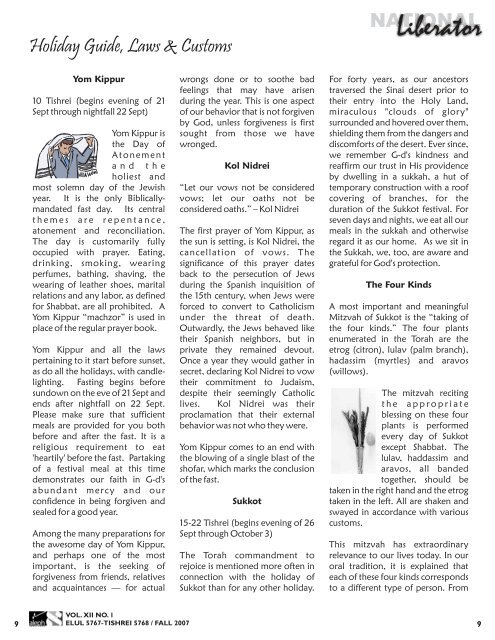Apple Dipped in Honey: For a Sweet New Year! - Jews in Green
Apple Dipped in Honey: For a Sweet New Year! - Jews in Green
Apple Dipped in Honey: For a Sweet New Year! - Jews in Green
You also want an ePaper? Increase the reach of your titles
YUMPU automatically turns print PDFs into web optimized ePapers that Google loves.
Holiday Guide, Laws & CustomsNATIONALLiberator.IYom Kippur10 Tishrei (beg<strong>in</strong>s even<strong>in</strong>g of 21Sept through nightfall 22 Sept)Yom Kippur isthe Day ofAtonementand theholiest andmost solemn day of the Jewishyear. It is the only Biblicallymandatedfast day. Its centralthemes are repentance,atonement and reconciliation.The day is customarily fullyoccupied with prayer. Eat<strong>in</strong>g,dr<strong>in</strong>k<strong>in</strong>g, smok<strong>in</strong>g, wear<strong>in</strong>gperfumes, bath<strong>in</strong>g, shav<strong>in</strong>g, thewear<strong>in</strong>g of leather shoes, maritalrelations and any labor, as def<strong>in</strong>edfor Shabbat, are all prohibited. AYom Kippur “machzor” is used <strong>in</strong>place of the regular prayer book.Yom Kippur and all the lawsperta<strong>in</strong><strong>in</strong>g to it start before sunset,as do all the holidays, with candlelight<strong>in</strong>g.Fast<strong>in</strong>g beg<strong>in</strong>s beforesundown on the eve of 21 Sept andends after nightfall on 22 Sept.Please make sure that sufficientmeals are provided for you bothbefore and after the fast. It is areligious requirement to eat'heartily' before the fast. Partak<strong>in</strong>gof a festival meal at this timedemonstrates our faith <strong>in</strong> G-d'sabundant mercy and ourconfidence <strong>in</strong> be<strong>in</strong>g forgiven andsealed for a good year.Among the many preparations forthe awesome day of Yom Kippur,and perhaps one of the mostimportant, is the seek<strong>in</strong>g offorgiveness from friends, relativesand acqua<strong>in</strong>tances — for actualwrongs done or to soothe badfeel<strong>in</strong>gs that may have arisendur<strong>in</strong>g the year. This is one aspectof our behavior that is not forgivenby God, unless forgiveness is firstsought from those we havewronged.Kol Nidrei“Let our vows not be consideredvows; let our oaths not beconsidered oaths.” – Kol NidreiThe first prayer of Yom Kippur, asthe sun is sett<strong>in</strong>g, is Kol Nidrei, thecancellation of vows. Thesignificance of this prayer datesback to the persecution of <strong>Jews</strong>dur<strong>in</strong>g the Spanish <strong>in</strong>quisition ofthe 15th century, when <strong>Jews</strong> wereforced to convert to Catholicismunder the threat of death.Outwardly, the <strong>Jews</strong> behaved liketheir Spanish neighbors, but <strong>in</strong>private they rema<strong>in</strong>ed devout.Once a year they would gather <strong>in</strong>secret, declar<strong>in</strong>g Kol Nidrei to vowtheir commitment to Judaism,despite their seem<strong>in</strong>gly Catholiclives. Kol Nidrei was theirproclamation that their externalbehavior was not who they were.Yom Kippur comes to an end withthe blow<strong>in</strong>g of a s<strong>in</strong>gle blast of theshofar, which marks the conclusionof the fast.Sukkot15-22 Tishrei (beg<strong>in</strong>s even<strong>in</strong>g of 26Sept through October 3)The Torah commandment torejoice is mentioned more often <strong>in</strong>connection with the holiday ofSukkot than for any other holiday.<strong>For</strong> forty years, as our ancestorstraversed the S<strong>in</strong>ai desert prior totheir entry <strong>in</strong>to the Holy Land,miraculous "clouds of glory"surrounded and hovered over them,shield<strong>in</strong>g them from the dangers anddiscomforts of the desert. Ever s<strong>in</strong>ce,we remember G-d's k<strong>in</strong>dness andreaffirm our trust <strong>in</strong> His providenceby dwell<strong>in</strong>g <strong>in</strong> a sukkah, a hut oftemporary construction with a roofcover<strong>in</strong>g of branches, for theduration of the Sukkot festival. <strong>For</strong>seven days and nights, we eat all ourmeals <strong>in</strong> the sukkah and otherwiseregard it as our home. As we sit <strong>in</strong>the Sukkah, we, too, are aware andgrateful for God's protection.The Four K<strong>in</strong>dsA most important and mean<strong>in</strong>gfulMitzvah of Sukkot is the “tak<strong>in</strong>g ofthe four k<strong>in</strong>ds.” The four plantsenumerated <strong>in</strong> the Torah are theetrog (citron), lulav (palm branch),hadassim (myrtles) and aravos(willows).The mitzvah recit<strong>in</strong>gthe appropriatebless<strong>in</strong>g on these fourplants is performedevery day of Sukkotexcept Shabbat. Thelulav, haddassim andaravos, all bandedtogether, should betaken <strong>in</strong> the right hand and the etrogtaken <strong>in</strong> the left. All are shaken andswayed <strong>in</strong> accordance with variouscustoms.This mitzvah has extraord<strong>in</strong>aryrelevance to our lives today. In ouroral tradition, it is expla<strong>in</strong>ed thateach of these four k<strong>in</strong>ds correspondsto a different type of person. From9VOL. XII NO. 1ELUL 5767-TISHREI 5768 / FALL 20079


